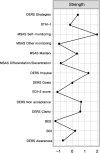Metacognition and emotion regulation as treatment targets in binge eating disorder: a network analysis study
- PMID: 33588943
- PMCID: PMC7885411
- DOI: 10.1186/s40337-021-00376-x
Metacognition and emotion regulation as treatment targets in binge eating disorder: a network analysis study
Abstract
Background: This study aims to examine the underlying associations between eating, affective and metacognitive symptoms in patients with binge eating disorder (BED) through network analysis (NA) in order to identify key variables that may be considered the target for psychotherapeutic interventions.
Methods: A total of 155 patients with BED completed measures of eating psychopathology, affective symptoms, emotion regulation and metacognition. A cross-sectional network was inferred by means of Gaussian Markov random field estimation using graphical LASSO and the extended Bayesian information criterion (EBIC-LASSO), and central symptoms of BED were identified by means of the strength centrality index.
Results: Impaired self-monitoring metacognition and difficulties in impulse control emerged as the symptoms with the highest centrality. Conversely, eating and affective features were less central. The centrality stability coefficient of strength was above the recommended cut-off, thus indicating the stability of the network.
Conclusions: According to the present NA findings, impaired self-monitoring metacognition and difficulties in impulse control are the central nodes in the psychopathological network of BED whereas eating symptoms appear marginal. If further studies with larger samples replicate these results, metacognition and impulse control could represent new targets of psychotherapeutic interventions in the treatment of BED. In light of this, metacognitive interpersonal therapy could be a promising aid in clinical practice to develop an effective treatment for BED.
Keywords: Binge eating disorder; Binge severity; Emotion dysregulation; Metacognition; Network analysis; Psychotherapy.
Conflict of interest statement
All the authors declare that they have no conflict of interest.
Figures


References
-
- APA AAP . Diagnostic and statistical manual of mental disorders (DSM-5®) 5. Arlington: American Psychiatric Association; 2013.
-
- National Institute for Health and Care Excellence . Eating disorders: Recognition and treatment. 2017. - PubMed
LinkOut - more resources
Full Text Sources
Other Literature Sources
Medical

